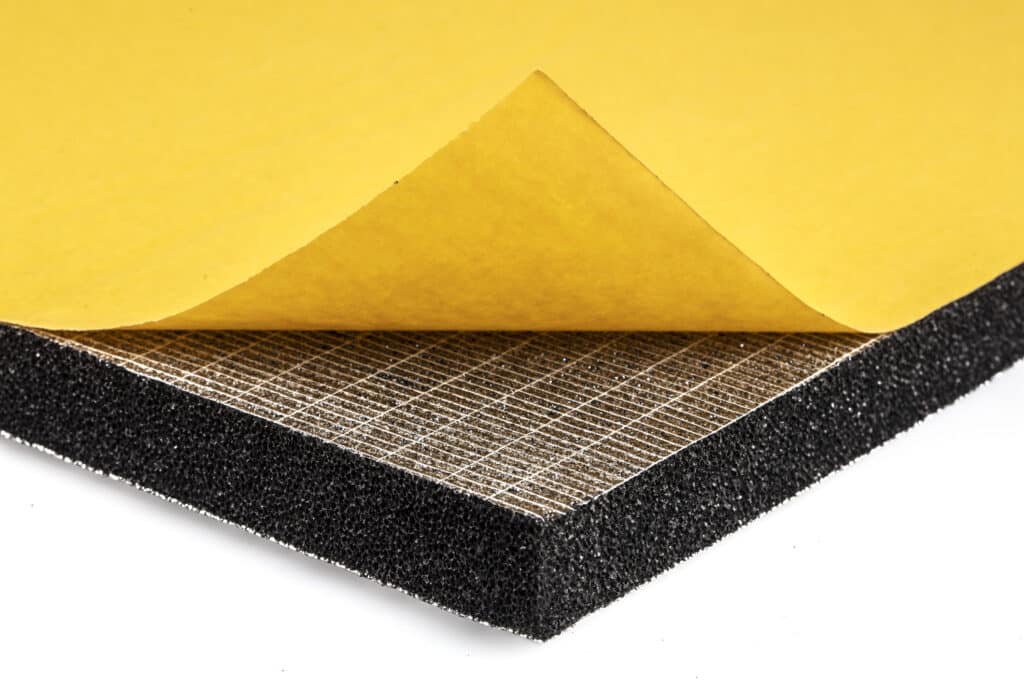
Maximizing Comfort with HVAC Soundproofing
HVAC soundproofing offers a solution to reduce the noise from heating, ventilation, and air conditioning systems, enhancing the tranquility of your living environment. This technique is becoming increasingly popular among homeowners seeking to create a more serene and comfortable space. By addressing the common noises that HVAC systems produce, soundproofing can significantly improve your home’s ambiance.
The concept of HVAC soundproofing revolves around minimizing the sound emitted by these essential systems. It involves various strategies that work together to dampen noise, ensuring that your home remains a peaceful haven. Whether it’s the hum of the air conditioner or the whir of the furnace, soundproofing helps in reducing these distractions. This makes it an invaluable investment for those looking to boost their home comfort levels.
Residents of Fort Worth, Colleyville, and Southlake are no strangers to the challenges of maintaining a quiet home amidst the hustle and bustle. HVAC soundproofing techniques offer a practical solution to this issue. By implementing these methods, you can enjoy a quieter home environment, free from the constant background noise of your HVAC system. This not only improves your quality of life but also contributes to a more peaceful and stress-free living space.
Understanding the basics of HVAC soundproofing is the first step towards achieving a quieter home. It’s about more than just comfort; it’s about creating a sanctuary where you can relax and unwind without the interference of external noises. As we delve deeper into the methods and benefits of HVAC soundproofing, remember that a quiet home is within reach. With the right approach, you can transform your living environment into a serene retreat, enhancing both comfort and tranquility.
Understanding the Basics of HVAC Soundproofing
To understand HVAC soundproofing, it’s essential to recognize the sources of noise within these systems. Typically, the loud sounds come from the equipment’s motors, fans, and air moving through ducts. In cities like Colleyville, TX, where homes are close together, these noises can be more pronounced and disruptive. Fortunately, soundproofing techniques can address these issues, leading to a significant reduction in unwanted noise.
One effective method for reducing HVAC noise is the installation of sound-dampening materials around the equipment. These materials absorb sound waves before they can travel through the air and into your living spaces. This approach is particularly beneficial in densely populated areas such as Southlake, TX, where external noises can compound the disturbance. By targeting the noise at its source, homeowners can enjoy a quieter and more peaceful environment.
Another strategy involves the strategic placement of the HVAC unit itself. Keeping it away from bedrooms and living areas can minimize the sound’s impact on the most used spaces in your home. Additionally, ensuring that the system is properly maintained can prevent the development of noises caused by wear and tear. Regular checks and servicing keep the system running smoothly, thus reducing the likelihood of noise disturbances.
Lastly, upgrading to newer, quieter HVAC models can also contribute to a more serene home environment. Modern units are designed with noise reduction in mind, featuring advanced technologies that lower sound output. While the initial focus might be on soundproofing existing systems, considering an upgrade can offer a long-term solution to noise issues. With these techniques, residents of Fort Worth and surrounding areas can achieve the tranquility they desire in their homes.
Types of Noise in HVAC Systems and How to Identify Them
In identifying the types of noise your HVAC system might be producing, it’s crucial to listen for buzzing, rattling, or humming sounds. These noises often indicate different issues, such as loose parts or electrical problems. By paying close attention to these sounds, homeowners in Southlake, TX, can better understand the nature of their HVAC soundproofing needs. This initial step is essential for targeting specific soundproofing solutions effectively.
Another common noise type comes from the airflow within the ducts, characterized by whistling or whooshing sounds. This can suggest that your ductwork might be too small, blocked, or improperly installed. Residents in Colleyville, TX, experiencing these airflow noises should consider inspecting their ducts. Addressing these issues not only contributes to noise reduction but also improves the efficiency of the HVAC system.
Vibrations are another indicator of potential problems, often resulting from the HVAC unit not being securely mounted. If the unit vibrates against the structure of your home, it can create a continuous and annoying sound. Ensuring that your HVAC system is properly installed and supported can significantly reduce these vibrations. This fix is particularly important in densely populated areas, where such noises can be more noticeable and bothersome.
Lastly, the sound of water running or dripping might not come to mind immediately when thinking of HVAC noise, but it’s a common issue. This noise usually points to a problem with the condensate drain. Regular maintenance checks can prevent or quickly resolve such issues, keeping your home in Fort Worth, TX, quiet and comfortable. By identifying these various noises, homeowners can take precise steps towards effective HVAC soundproofing, enhancing the tranquility of their living environment.

Essential Materials for Effective HVAC Soundproofing
When embarking on the journey of HVAC soundproofing, selecting the right materials is crucial. Acoustic foam panels, known for their sound-absorbing qualities, can effectively dampen the noise when installed around the HVAC unit or in the ductwork. This approach not only reduces the sound emanating from the system but also enhances the overall quietness of your home in Colleyville, TX. The strategic placement of these panels plays a significant role in maximizing their effectiveness.
Another essential material for HVAC soundproofing is mass-loaded vinyl (MLV). This dense, yet flexible material acts as a sound barrier, blocking noise from escaping into living spaces. Homeowners can line the interior of their HVAC closets or enclosures with MLV, significantly cutting down on the amount of noise that penetrates through walls and ceilings. Its versatility makes it a popular choice for those seeking a quieter environment in Southlake, TX.
For those dealing with duct-related noises, installing duct wrap is an effective solution. This insulation material not only improves energy efficiency but also serves as a sound absorber, reducing the noise produced by air moving through the ducts. By wrapping exposed ducts with this material, homeowners can address the whistling and whooshing sounds that often disrupt the peace within their homes. This method ensures a more serene atmosphere, allowing for undisturbed relaxation and comfort.
Lastly, rubber mounts and pads offer a simple yet effective means of minimizing vibration noises. By placing these beneath the HVAC unit, vibrations caused by the system’s operation are significantly reduced. This prevents the sound from transmitting through the floors and walls of your home, offering an immediate improvement in noise levels. Such minor adjustments can make a substantial difference in the overall ambiance of your living space, marking a critical step towards achieving the desired tranquility through HVAC soundproofing.
Step-by-Step Guide to Soundproofing Your HVAC Unit
Embarking on HVAC soundproofing begins with isolating the unit from its surroundings. Installing a soundproofing enclosure around the HVAC system effectively blocks noise from spreading. This enclosure can be built using materials like acoustic foam or mass-loaded vinyl, known for their sound-blocking properties. Such a setup ensures that the hum and buzz of the unit stay contained, enhancing the quietness of your home in Colleyville, TX.
Next, focus on the ductwork, a common noise pathway in HVAC systems. Applying duct wrap around the ducts acts as a barrier, absorbing sound vibrations caused by air movement. This step not only quiets the noise but also improves the system’s efficiency by maintaining consistent temperature control. Residents in Southlake, TX, will find this method particularly beneficial in creating a more peaceful living environment.
Vibration isolators present a simple yet effective solution for reducing noise transmission. These rubber or foam pads can be placed under the HVAC unit and along the ductwork to dampen vibrations. By preventing the unit’s vibrations from reaching the structure of your home, you significantly reduce the noise level. This measure is a straightforward approach to minimizing the operational sounds of your HVAC system.
Lastly, regular maintenance plays a pivotal role in preventing noise issues before they start. Ensuring that your HVAC system is in top condition involves tightening loose components and addressing any wear and tear. A well-maintained unit operates more quietly and efficiently, avoiding the common pitfalls of noise generation. Through these steps, homeowners can achieve effective HVAC soundproofing, resulting in a more tranquil and comfortable living space.
Professional vs. DIY HVAC Soundproofing: What You Need to Know
When considering HVAC soundproofing, homeowners often weigh the benefits of professional services against the allure of DIY projects. Professionals bring expertise and access to high-quality materials, ensuring that soundproofing measures are correctly and efficiently implemented. This can be particularly reassuring for residents in Colleyville, TX, who seek a seamless blend of tranquility and efficiency in their HVAC systems. In contrast, DIY soundproofing allows for personal involvement and can be a rewarding challenge for those who are handy.
However, DIY approaches to HVAC soundproofing come with their own set of challenges. Without the proper knowledge, one might improperly install soundproofing materials, leading to less effective noise reduction. This can be a significant concern in densely populated areas like Southlake, TX, where even a slight reduction in noise can make a big difference in home comfort. Additionally, sourcing the right materials can be a hurdle for individuals not familiar with the industry standards.
On the flip side, hiring professionals for HVAC soundproofing offers a hassle-free experience with guaranteed results. Experts in the field can assess the specific needs of your home, taking into account the layout and the existing HVAC system to devise a tailored solution. This ensures that the soundproofing not only reduces noise but also does not impede the system’s performance or efficiency.
Ultimately, the choice between professional and DIY HVAC soundproofing depends on one’s confidence in their skills, the complexity of the project, and the desired outcome. While professionals guarantee a certain level of quality and reliability, DIY projects can offer satisfaction and a sense of accomplishment. Regardless of the path chosen, the goal remains the same: to achieve a quieter, more comfortable home environment through effective HVAC soundproofing.
The Role of Maintenance in Reducing HVAC Noise
Regular maintenance is crucial in the pursuit of HVAC soundproofing, serving as a preventative measure against unnecessary noise. By scheduling routine check-ups, homeowners in Colleyville, TX, can ensure their systems operate smoothly, reducing the likelihood of sounds caused by malfunction or wear and tear. These inspections can identify and rectify potential issues before they escalate into noisy problems, maintaining a serene home environment.
In Southlake, TX, professional technicians play a vital role in the maintenance process, applying their expertise to optimize HVAC performance. Their skills are essential in detecting loose components or obstructions that may cause vibrations or airflow noises. By tightening and cleaning as needed, they help sustain the system’s quiet operation, contributing to the overall comfort of your home.
The role of cleaning in HVAC soundproofing should not be underestimated, as a clean system is a quieter system. Dust and debris accumulation can lead to inefficiencies and noise, particularly in the fan and ductwork. Regular cleaning ensures air flows smoothly and quietly, enhancing the effectiveness of soundproofing measures already in place.
Finally, the replacement of worn-out parts during maintenance visits can significantly reduce HVAC noise. Over time, components like belts and bearings can wear down, leading to rattling or buzzing sounds. Replacing these parts not only extends the life of the system but also contributes to a quieter, more peaceful living space, aligning with the goals of HVAC soundproofing.
Innovative HVAC Soundproofing Techniques for Modern Homes
Exploring innovative HVAC soundproofing techniques can significantly enhance the comfort of modern homes. In Colleyville, TX, homeowners have begun adopting smart zoning systems. These systems allow for the precise control of temperature in different areas, reducing the need for the HVAC system to work as hard and, consequently, lowering noise levels. By focusing on efficiency and targeted cooling or heating, smart zoning presents a forward-thinking approach to maintaining a tranquil home environment.
Another method gaining traction involves the use of soundproofing curtains or blankets around HVAC areas. These specially designed curtains can absorb sound waves, preventing them from entering living spaces. Homeowners in Southlake, TX, find this solution not only practical but also aesthetically pleasing. It offers an easy and effective way to dampen noise without the need for extensive modifications to the HVAC system itself.
The integration of anti-vibration mounts and isolation techniques has also proven to be a game-changer in HVAC soundproofing. By installing these mounts, the transmission of vibrations from the HVAC unit to the structure of the home is minimized. This results in a noticeable reduction in noise, making it an ideal solution for those seeking peace and quiet. It’s a testament to how small changes can make a significant difference in noise levels.
Lastly, advancements in ductwork design have introduced quieter and more efficient air flow. Modern duct systems are being designed to minimize noise through smoother transitions and less turbulent air flow. This not only contributes to a quieter home but also enhances the overall efficiency of the HVAC system. As these innovative techniques become more widespread, homeowners can look forward to enjoying both comfort and tranquility in their living spaces.
Evaluating the Impact of HVAC Soundproofing on Energy Efficiency
HVAC soundproofing not only enhances the tranquility of your home but also contributes to energy efficiency. By implementing soundproofing measures, systems operate more smoothly, reducing the need for frequent cycling on and off. This streamlined operation means your HVAC doesn’t have to work as hard to maintain a comfortable temperature in your home, leading to savings on energy costs. Homeowners in Colleyville, TX, have noticed that after soundproofing their HVAC systems, their energy bills have decreased, showcasing the dual benefits of this approach.
In Southlake, TX, residents who have adopted HVAC soundproofing techniques report an improvement in system efficiency. Soundproofing materials can also serve as additional insulation, keeping conditioned air where it’s supposed to be. This reduction in air leakage not only cuts down on noise but also prevents the HVAC system from overworking to compensate for lost air. As a result, the system uses less energy, which is both environmentally friendly and cost-effective.
Moreover, quieter HVAC systems tend to have a longer lifespan because they experience less wear and tear from constant use. When a system is properly soundproofed, it runs less frequently and with less strain on its components. This gentle operation helps to preserve the system’s overall health, ensuring that residents in Fort Worth, TX, enjoy efficient heating and cooling for years to come. Consequently, the need for repairs and replacements diminishes, further enhancing energy efficiency and reducing waste.
Lastly, the process of HVAC soundproofing indirectly encourages homeowners to engage in regular maintenance and inspections. Through these checks, any issues that could hinder the system’s efficiency are promptly addressed. Residents in both Colleyville and Southlake, TX, have found that combining soundproofing with consistent maintenance leads to optimal system performance. This not only ensures a quieter home environment but also maximizes energy efficiency, striking a perfect balance between comfort and sustainability.

Frequently Asked Questions
What is HVAC soundproofing?
HVAC soundproofing involves techniques to reduce noise from heating, ventilation, and air conditioning systems. It enhances indoor comfort by minimizing disruptive sounds. Effective soundproofing can transform a noisy environment into a tranquil space. This process is key to enjoying a quieter, more peaceful home.
How does soundproofing improve comfort?
Soundproofing your HVAC system enhances overall comfort by significantly reducing noise levels in your home. It allows for a more peaceful environment, making relaxation and concentration easier. By dampening the sound of running heating and cooling systems, it also improves sleep quality. Ultimately, HVAC soundproofing contributes to a serene living space where quiet moments are cherished.
Can HVAC soundproofing reduce energy costs?
Yes, HVAC soundproofing can lead to reduced energy expenses. By optimizing system efficiency, it ensures your unit runs smoothly, needing less power. A well-insulated system retains heat or cool air better, reducing the workload on your HVAC. This process not only quiets your home but also makes your energy use more efficient, saving resources in the long run.
What materials are used in HVAC soundproofing?
Various materials are essential for effective HVAC soundproofing. Acoustic foam panels absorb sound, reducing noise from the HVAC unit. Mass-loaded vinyl barriers block external noise, enhancing indoor tranquility. Rubber mounts isolate vibrations, making the system quieter. Lastly, flexible ducts minimize the sound of air movement, contributing to a more peaceful home environment.
How long does HVAC soundproofing last?
The lifespan of HVAC soundproofing depends on the materials used and the system’s maintenance. High-quality soundproofing materials can last as long as your HVAC system with proper care. Regular checks and updates to soundproofing components ensure they remain effective. Ultimately, durable soundproofing enhances your home’s tranquility for years.


